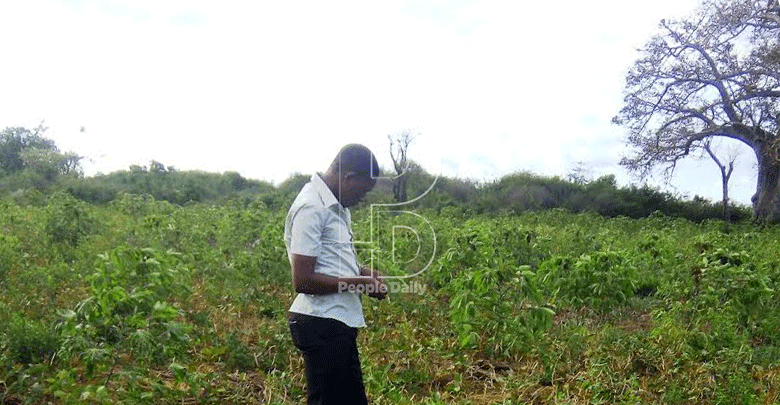Climate change wrath sinks hopes of coastal farmers
By Harrison Kivisu, August 10, 2021When Alfred Kiti planted maize on his farm in March this year, he had high hopes to get a bumper harvest after the end of the rainy season.
The 51-year-old is a seasoned maize farmer in Kilifi county, who has for over 20 years depended on the venture to feed his family and sell the the extra harvest to educate his children.
A resident of Mtondia, Maweni village, Kiti says unreliable rain at the coast this year caught him off guard and now his crops have started drying up.
In April this year, the National Drought Management Authority (NDMA) released an advisory to farmers asking them to plant drought resistant crops due to poor distribution of rain in most parts of the coastal region.
But Kiti, alongside other coastal farmers, did not heed to the advice as he had no alternative seeds.
Kiti represents a bigger percentage of farmers in Kilifi who will not harvest this season.
“I used to get twenty 90kg bags of maize, when the season’s rains were reliable, but this year there is no hope due to lack of enough rains.
This year, I am totally affected. I planted two acres and there is no hope of any harvest,” narrates Kiti.
Crops planted between between March and April have started drying up in parts of Magarini, Ganze and Kinago areas of the coast region.
“Drought will obviously catch up with us because the crops we planted are in the off-season rainy season, which has already ended, others have started drying up,” Kiti says.

Many communities in the region are staring at a severe hunger and their only hope is to have the government intervene and start distributing relief food.
Never seen before
“This year is very harsh. We haven’t experienced something like this before. We used to harvest a lot of maize from here.
I planted normal maize seeds because we did not have the drought resistant seeds,” said Kiti.
Kilifi county and a section of Kwale county have been facing drought for years, but the situation has escalated this year even as the government embarks on a long lasting solution.
At Magarini village, Francis Mupe is also in pain. He has had to replant his maize after they had dried up on first attempts. He says a severe drought is staring at him.
“We are already feeling the impact of unreliable rains this year. Our crops and grazing areas have started drying up,” said Mupe, calling for early interventions by the state.
Already in Kwale county, residents have started experiencing drought. Kilifi county Red Cross Kenya coordinator Cornel Ndombi discloses that they are prepared to handle the after effects of hunger.
According to the Kenya Meteorological Department (KMD), the coastal region did not receive rains during its April and May season.
KMD reports the region received15 per cent of rains less than what they are supposed to get across Lamu and Kwale counties.
The unprecedented climatic change has affected farmers who planted off-season after the April-May rain season delayed. Kilifi and Tana River counties are the most affected.
“Our appeal is to the county government and the meteorological department to advise farmers on what crops to plant next so that we can prepare,” said Kiti.
Kilifi county NDMA director Adam Kheri says a multi-agency committee is conducting assessment in parts of Ganze, Magarini and Rabai, labelled as hinterlands to establish the impact of the situation and the necessary interventions to be undertaken.
“We are awaiting a report, which is being compiled by multi-agency stakeholders, so that we can start interventions.
It’s true, a very huge population is already being affected. Some organisations have started cash transfer programmes to the seriously affected,” he explained.
“For the last one year the rains have failed in the coast. This means there will be no harvesting.
It’s up to the counties to look at measures to cushion this large population,” said Lamu county meteorological office director Edward Ngure.
Roman Shera,Kwale NDMA director said hundreds of families are in serious need of food and the situation may worsen in three months’ time.
“We estimate about 10 per cent of the entire Kwale population is in dire need of food. Already, interventions are in the pipeline to start food distribution to the families affected,“ said Shera.
Shift to cassava farming
The affected areas are Kinango constituency and parts of Lungalunga sub-county.
“There is no rain in Kinango, all crops dried up and we don’t expect any good harvest for the few who had planted.
This tells you there is drought and famine,” said said Julius Mwang’ombe, a maize farmer in Kinango sub-county in the county.
According to Andrew Mwangovi, executive director, Shamba Project a Non-Governmental Organisation that deals with farmer’s empowerment says majority of farmers will experience drought because they lacked drought resistance seeds to plant.
“We have been providing farmers with the best seeds to plant and also offer education and training,but due to poor funding, we did not do so this season,”said Mwangovi.
Statistics from Kilifi agriculture department show that more than 10,000 farmers from Kaloleni, Rabai and Kilifi South have embraced farming of drough resistant cassava to stay afloat.
“We deal with small holder farmers. We train them and offer them up to date information and innovative technologies to enable them to produce more and earn a better living from farming,” Mwangovi says.